Comprehensive Report: Online Bookstore System Analysis and Design
VerifiedAdded on 2023/05/29
|14
|2626
|169
Report
AI Summary
This report provides a comprehensive analysis and design of an online bookstore system. It begins with a detailed data dictionary defining the data stores for customers, books, and shopping carts, including data types, sources, and examples. The report then delves into the System Development Life Cycle (SDLC), outlining each phase from planning and requirements engineering to system design, development (using an agile approach with Scrum), integration, testing, deployment, and maintenance. The report also covers system analysis and design, emphasizing requirements gathering and the importance of minimizing changes. Furthermore, it includes a SWOT analysis to assess the system's strengths, weaknesses, opportunities, and threats, alongside a feasibility study encompassing technical, operational, economic, and schedule aspects. Finally, the report touches upon content management systems and system development standards within analysis and design documentation.

COVER PAGE
Paraphrase This Document
Need a fresh take? Get an instant paraphrase of this document with our AI Paraphraser
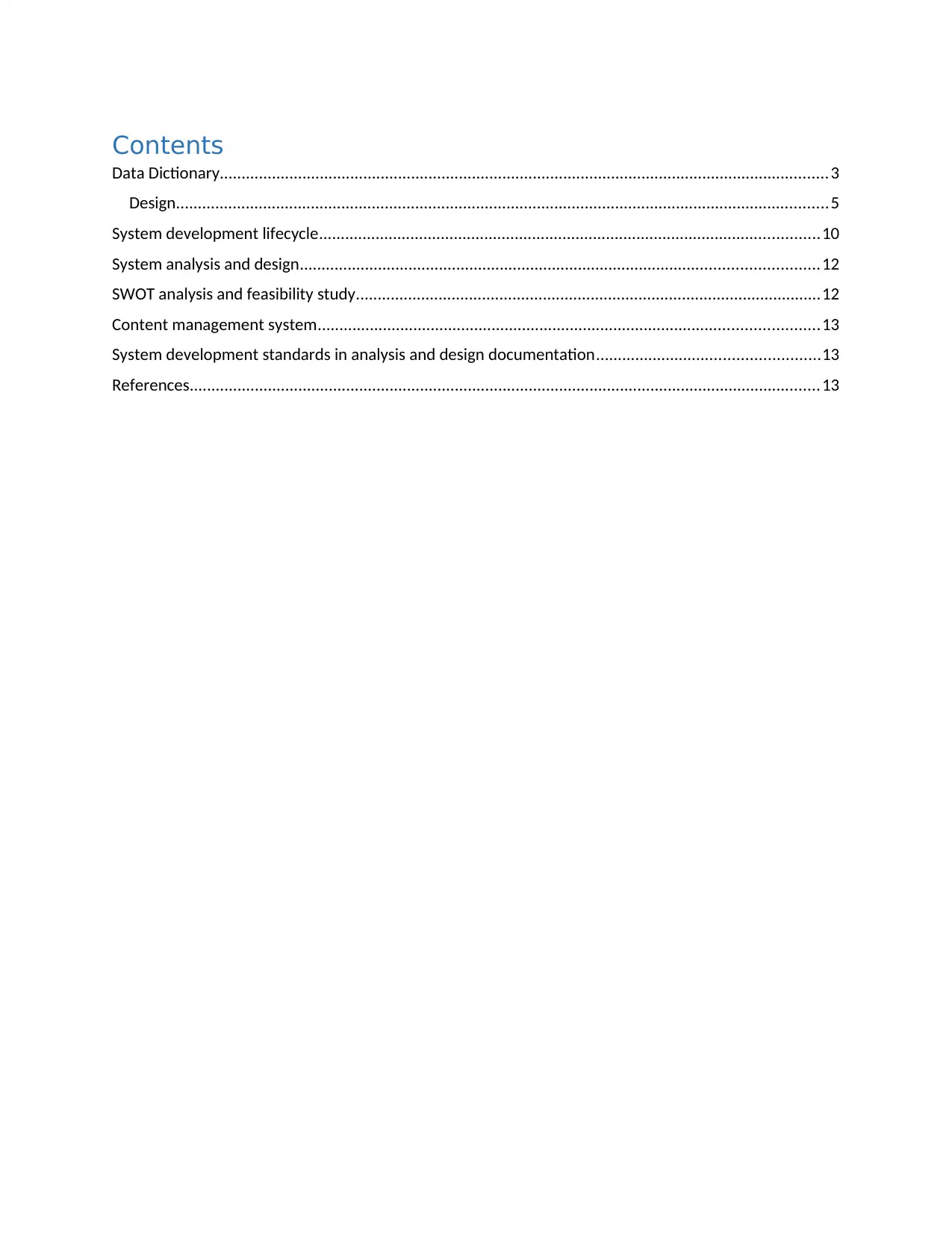
Contents
Data Dictionary............................................................................................................................................3
Design......................................................................................................................................................5
System development lifecycle...................................................................................................................10
System analysis and design.......................................................................................................................12
SWOT analysis and feasibility study...........................................................................................................12
Content management system...................................................................................................................13
System development standards in analysis and design documentation...................................................13
References.................................................................................................................................................13
Data Dictionary............................................................................................................................................3
Design......................................................................................................................................................5
System development lifecycle...................................................................................................................10
System analysis and design.......................................................................................................................12
SWOT analysis and feasibility study...........................................................................................................12
Content management system...................................................................................................................13
System development standards in analysis and design documentation...................................................13
References.................................................................................................................................................13
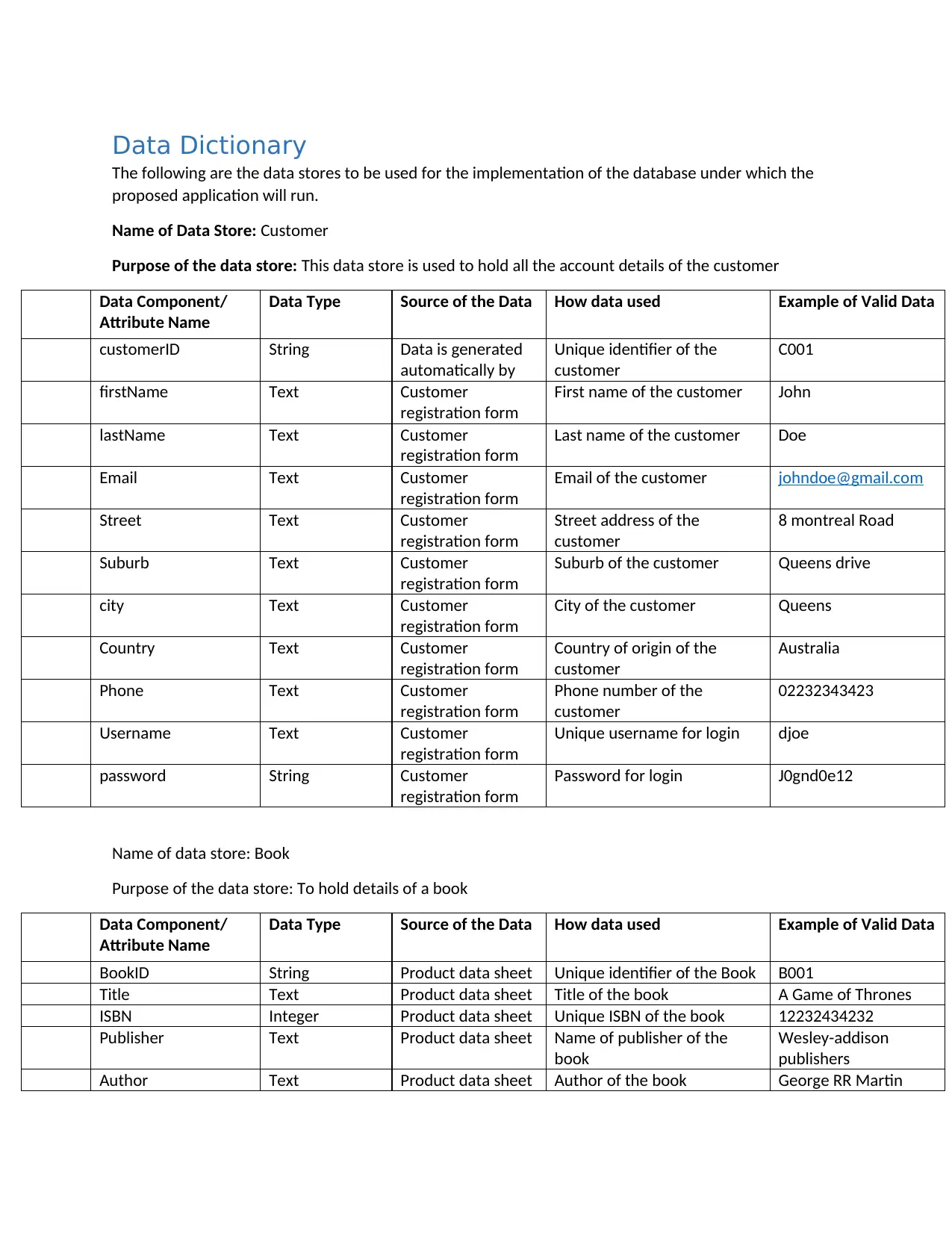
Data Dictionary
The following are the data stores to be used for the implementation of the database under which the
proposed application will run.
Name of Data Store: Customer
Purpose of the data store: This data store is used to hold all the account details of the customer
Data Component/
Attribute Name
Data Type Source of the Data How data used Example of Valid Data
customerID String Data is generated
automatically by
Unique identifier of the
customer
C001
firstName Text Customer
registration form
First name of the customer John
lastName Text Customer
registration form
Last name of the customer Doe
Email Text Customer
registration form
Email of the customer johndoe@gmail.com
Street Text Customer
registration form
Street address of the
customer
8 montreal Road
Suburb Text Customer
registration form
Suburb of the customer Queens drive
city Text Customer
registration form
City of the customer Queens
Country Text Customer
registration form
Country of origin of the
customer
Australia
Phone Text Customer
registration form
Phone number of the
customer
02232343423
Username Text Customer
registration form
Unique username for login djoe
password String Customer
registration form
Password for login J0gnd0e12
Name of data store: Book
Purpose of the data store: To hold details of a book
Data Component/
Attribute Name
Data Type Source of the Data How data used Example of Valid Data
BookID String Product data sheet Unique identifier of the Book B001
Title Text Product data sheet Title of the book A Game of Thrones
ISBN Integer Product data sheet Unique ISBN of the book 12232434232
Publisher Text Product data sheet Name of publisher of the
book
Wesley-addison
publishers
Author Text Product data sheet Author of the book George RR Martin
The following are the data stores to be used for the implementation of the database under which the
proposed application will run.
Name of Data Store: Customer
Purpose of the data store: This data store is used to hold all the account details of the customer
Data Component/
Attribute Name
Data Type Source of the Data How data used Example of Valid Data
customerID String Data is generated
automatically by
Unique identifier of the
customer
C001
firstName Text Customer
registration form
First name of the customer John
lastName Text Customer
registration form
Last name of the customer Doe
Email Text Customer
registration form
Email of the customer johndoe@gmail.com
Street Text Customer
registration form
Street address of the
customer
8 montreal Road
Suburb Text Customer
registration form
Suburb of the customer Queens drive
city Text Customer
registration form
City of the customer Queens
Country Text Customer
registration form
Country of origin of the
customer
Australia
Phone Text Customer
registration form
Phone number of the
customer
02232343423
Username Text Customer
registration form
Unique username for login djoe
password String Customer
registration form
Password for login J0gnd0e12
Name of data store: Book
Purpose of the data store: To hold details of a book
Data Component/
Attribute Name
Data Type Source of the Data How data used Example of Valid Data
BookID String Product data sheet Unique identifier of the Book B001
Title Text Product data sheet Title of the book A Game of Thrones
ISBN Integer Product data sheet Unique ISBN of the book 12232434232
Publisher Text Product data sheet Name of publisher of the
book
Wesley-addison
publishers
Author Text Product data sheet Author of the book George RR Martin
⊘ This is a preview!⊘
Do you want full access?
Subscribe today to unlock all pages.

Trusted by 1+ million students worldwide
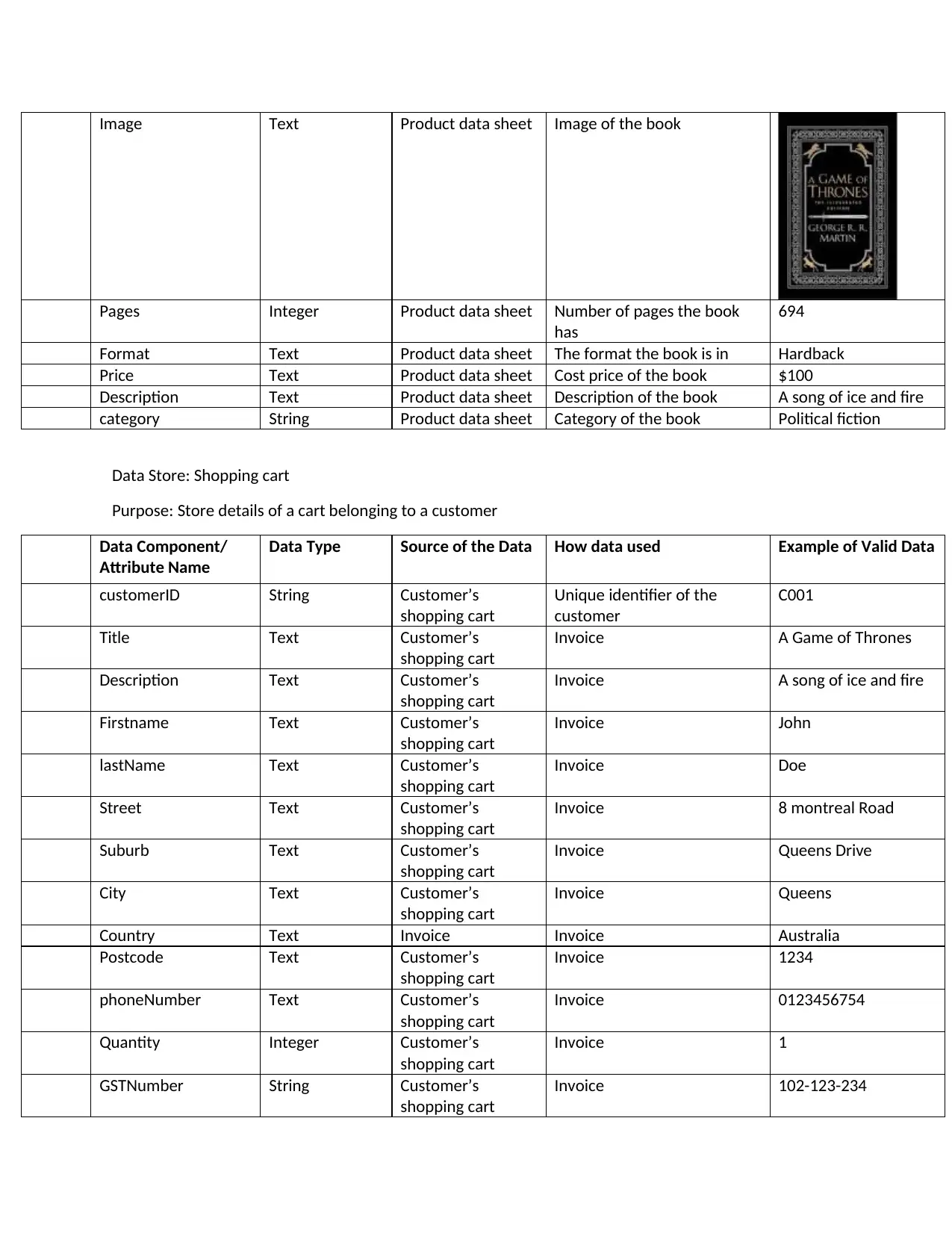
Image Text Product data sheet Image of the book
Pages Integer Product data sheet Number of pages the book
has
694
Format Text Product data sheet The format the book is in Hardback
Price Text Product data sheet Cost price of the book $100
Description Text Product data sheet Description of the book A song of ice and fire
category String Product data sheet Category of the book Political fiction
Data Store: Shopping cart
Purpose: Store details of a cart belonging to a customer
Data Component/
Attribute Name
Data Type Source of the Data How data used Example of Valid Data
customerID String Customer’s
shopping cart
Unique identifier of the
customer
C001
Title Text Customer’s
shopping cart
Invoice A Game of Thrones
Description Text Customer’s
shopping cart
Invoice A song of ice and fire
Firstname Text Customer’s
shopping cart
Invoice John
lastName Text Customer’s
shopping cart
Invoice Doe
Street Text Customer’s
shopping cart
Invoice 8 montreal Road
Suburb Text Customer’s
shopping cart
Invoice Queens Drive
City Text Customer’s
shopping cart
Invoice Queens
Country Text Invoice Invoice Australia
Postcode Text Customer’s
shopping cart
Invoice 1234
phoneNumber Text Customer’s
shopping cart
Invoice 0123456754
Quantity Integer Customer’s
shopping cart
Invoice 1
GSTNumber String Customer’s
shopping cart
Invoice 102-123-234
Pages Integer Product data sheet Number of pages the book
has
694
Format Text Product data sheet The format the book is in Hardback
Price Text Product data sheet Cost price of the book $100
Description Text Product data sheet Description of the book A song of ice and fire
category String Product data sheet Category of the book Political fiction
Data Store: Shopping cart
Purpose: Store details of a cart belonging to a customer
Data Component/
Attribute Name
Data Type Source of the Data How data used Example of Valid Data
customerID String Customer’s
shopping cart
Unique identifier of the
customer
C001
Title Text Customer’s
shopping cart
Invoice A Game of Thrones
Description Text Customer’s
shopping cart
Invoice A song of ice and fire
Firstname Text Customer’s
shopping cart
Invoice John
lastName Text Customer’s
shopping cart
Invoice Doe
Street Text Customer’s
shopping cart
Invoice 8 montreal Road
Suburb Text Customer’s
shopping cart
Invoice Queens Drive
City Text Customer’s
shopping cart
Invoice Queens
Country Text Invoice Invoice Australia
Postcode Text Customer’s
shopping cart
Invoice 1234
phoneNumber Text Customer’s
shopping cart
Invoice 0123456754
Quantity Integer Customer’s
shopping cart
Invoice 1
GSTNumber String Customer’s
shopping cart
Invoice 102-123-234
Paraphrase This Document
Need a fresh take? Get an instant paraphrase of this document with our AI Paraphraser
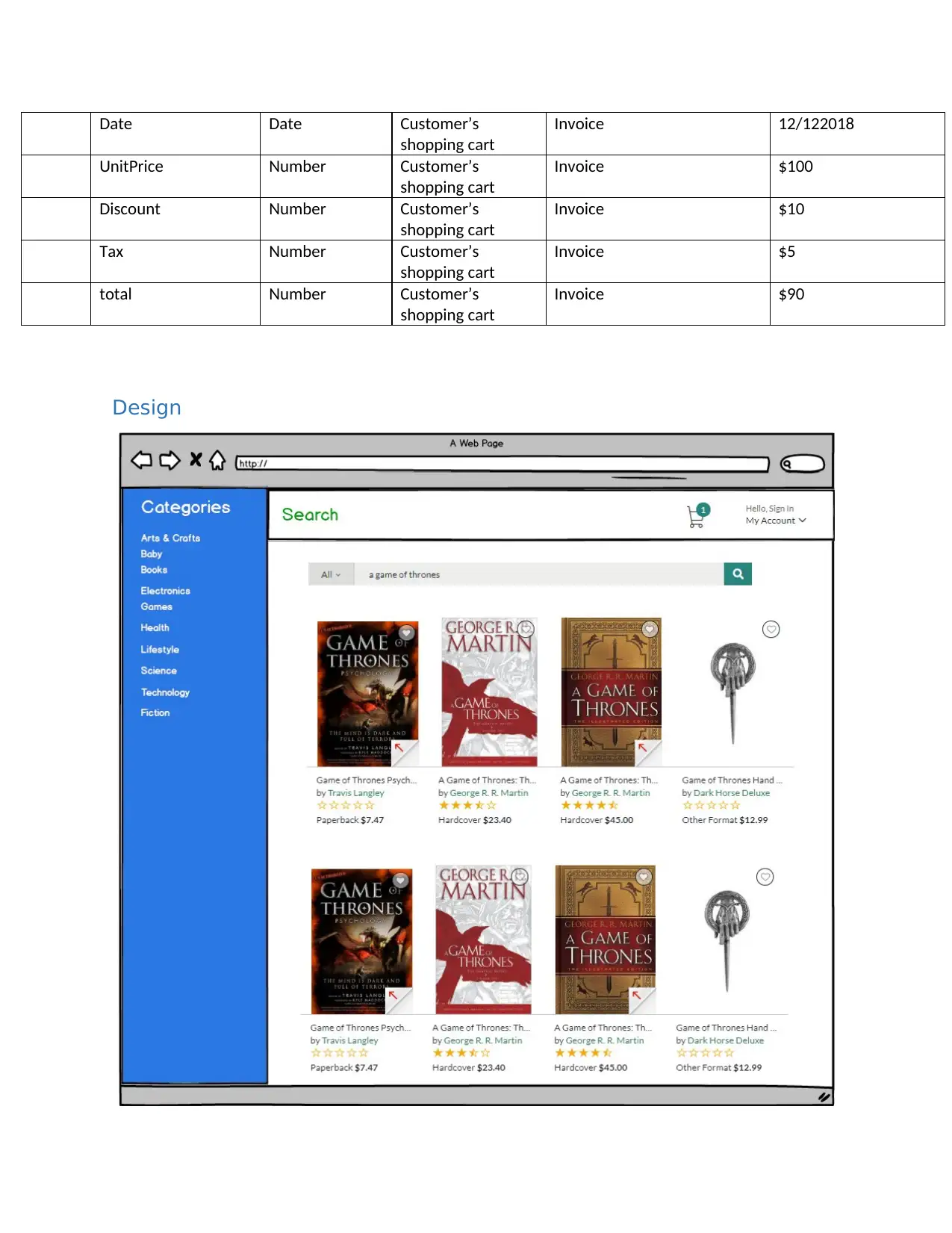
Date Date Customer’s
shopping cart
Invoice 12/122018
UnitPrice Number Customer’s
shopping cart
Invoice $100
Discount Number Customer’s
shopping cart
Invoice $10
Tax Number Customer’s
shopping cart
Invoice $5
total Number Customer’s
shopping cart
Invoice $90
Design
shopping cart
Invoice 12/122018
UnitPrice Number Customer’s
shopping cart
Invoice $100
Discount Number Customer’s
shopping cart
Invoice $10
Tax Number Customer’s
shopping cart
Invoice $5
total Number Customer’s
shopping cart
Invoice $90
Design

⊘ This is a preview!⊘
Do you want full access?
Subscribe today to unlock all pages.

Trusted by 1+ million students worldwide
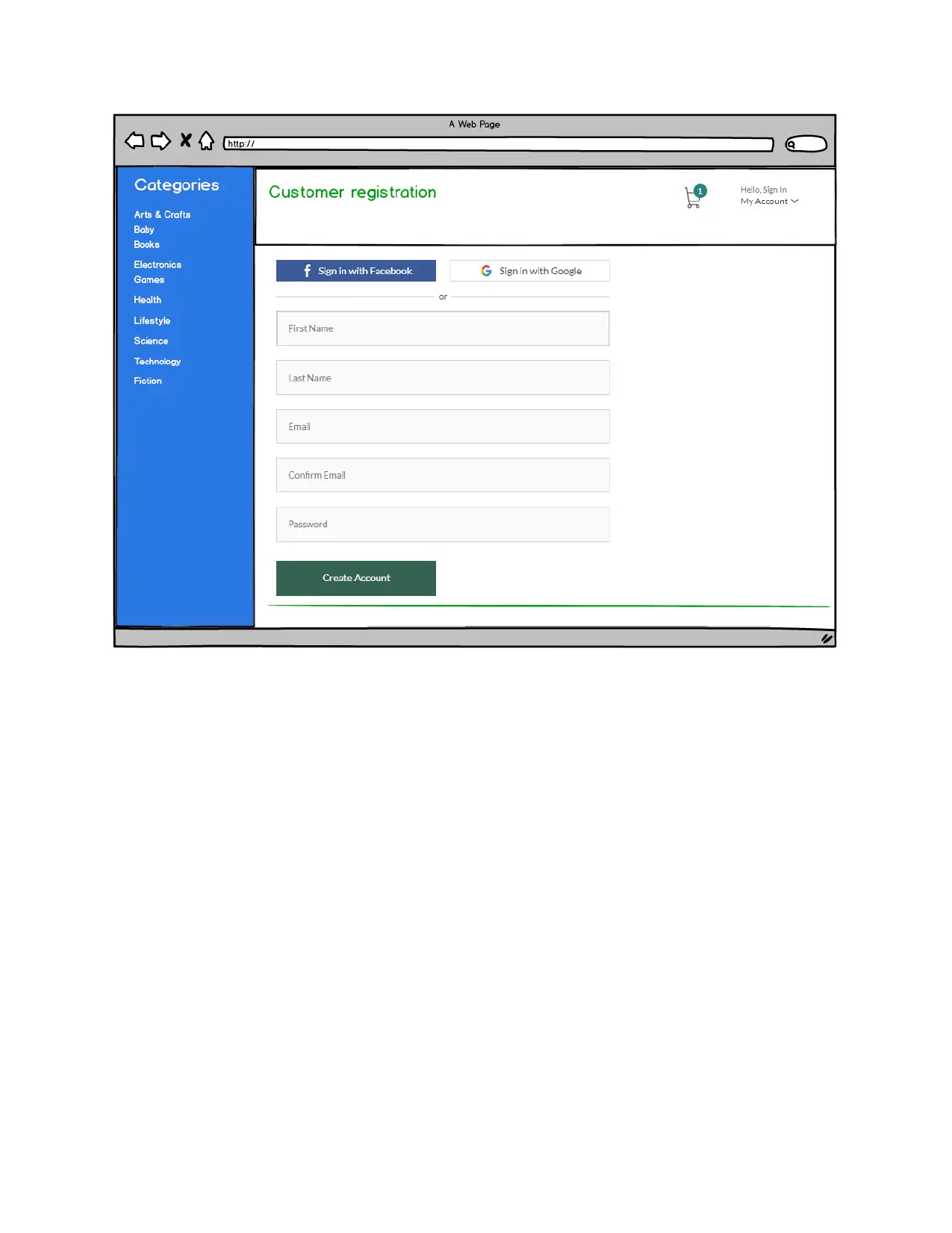
Paraphrase This Document
Need a fresh take? Get an instant paraphrase of this document with our AI Paraphraser
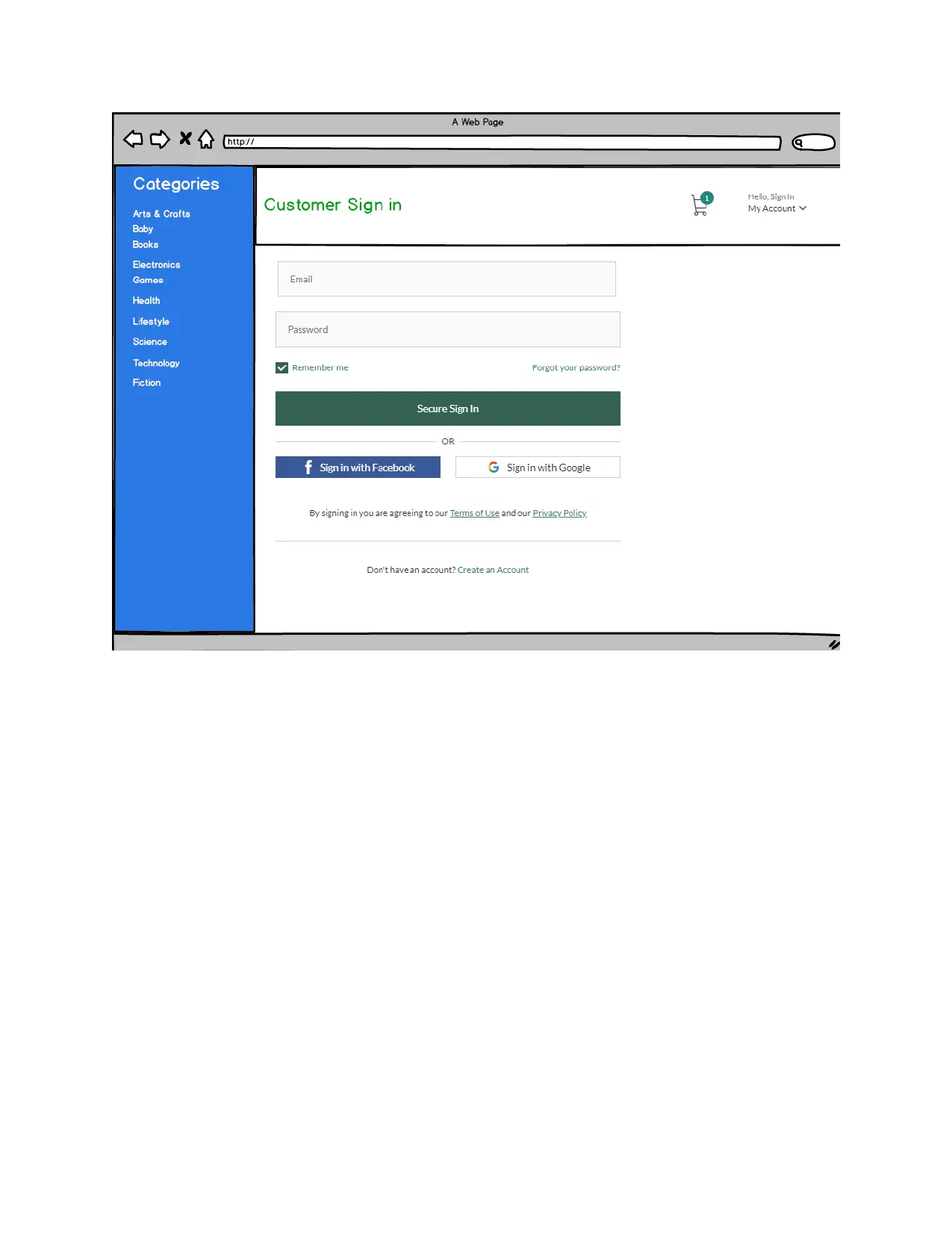
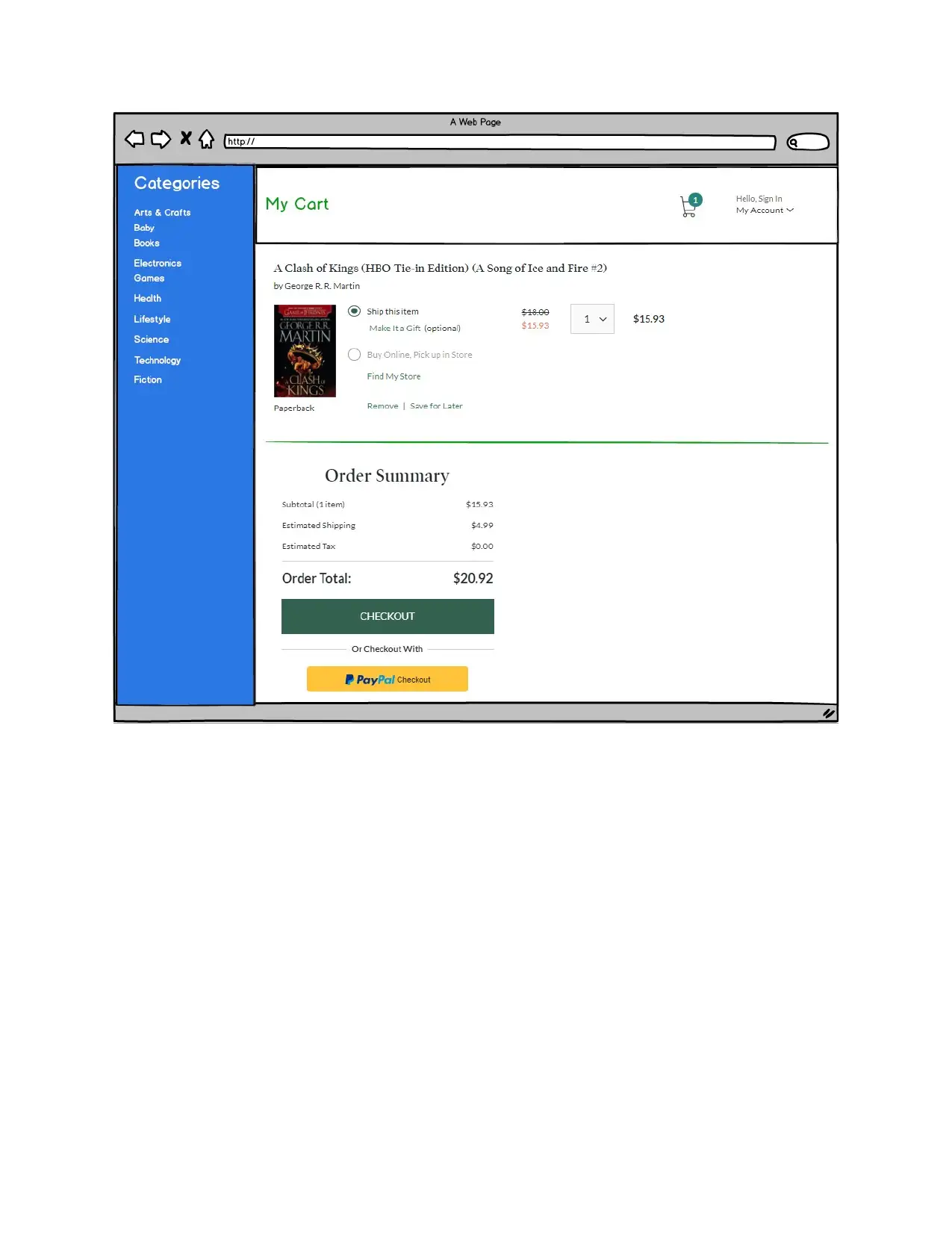
⊘ This is a preview!⊘
Do you want full access?
Subscribe today to unlock all pages.

Trusted by 1+ million students worldwide
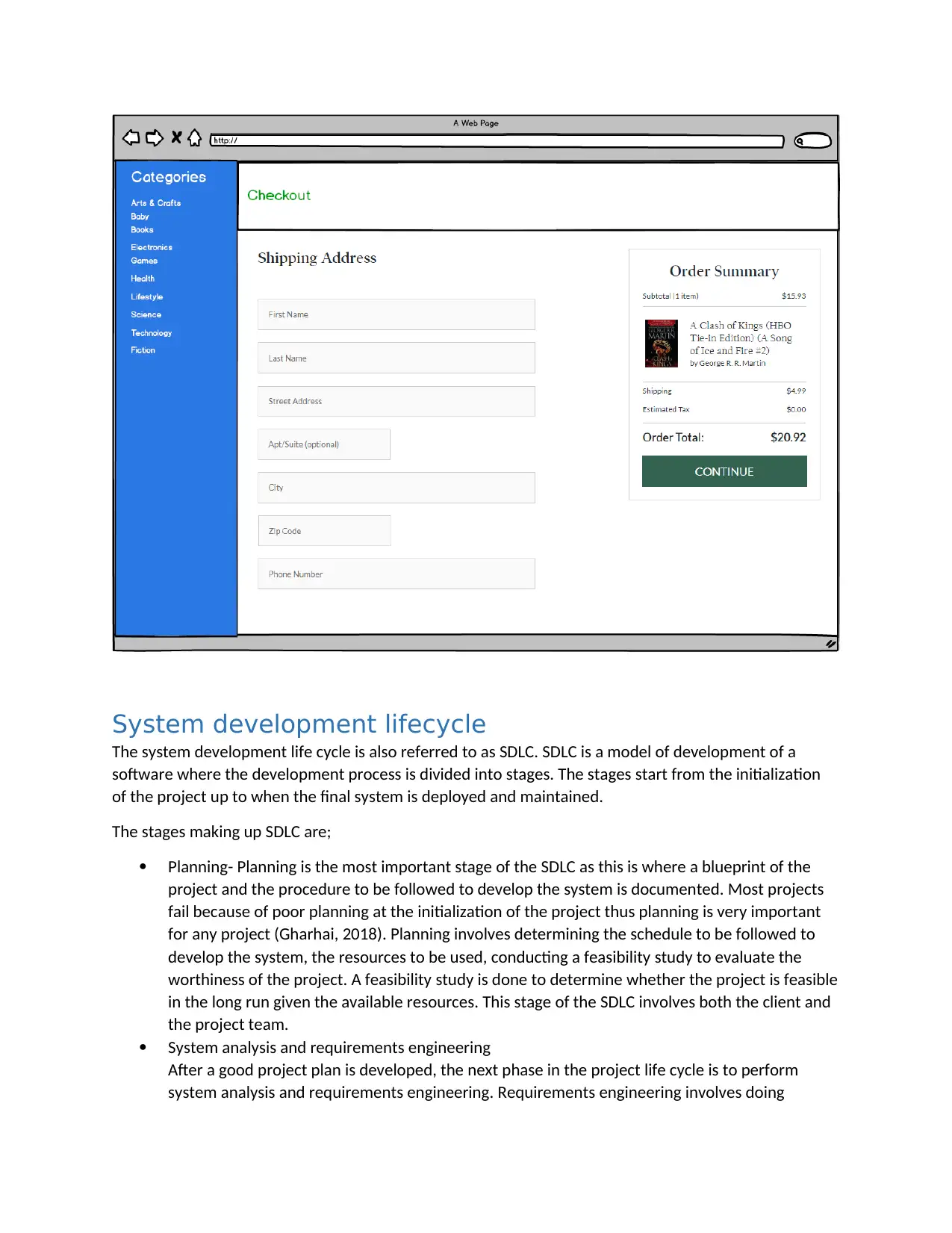
System development lifecycle
The system development life cycle is also referred to as SDLC. SDLC is a model of development of a
software where the development process is divided into stages. The stages start from the initialization
of the project up to when the final system is deployed and maintained.
The stages making up SDLC are;
Planning- Planning is the most important stage of the SDLC as this is where a blueprint of the
project and the procedure to be followed to develop the system is documented. Most projects
fail because of poor planning at the initialization of the project thus planning is very important
for any project (Gharhai, 2018). Planning involves determining the schedule to be followed to
develop the system, the resources to be used, conducting a feasibility study to evaluate the
worthiness of the project. A feasibility study is done to determine whether the project is feasible
in the long run given the available resources. This stage of the SDLC involves both the client and
the project team.
System analysis and requirements engineering
After a good project plan is developed, the next phase in the project life cycle is to perform
system analysis and requirements engineering. Requirements engineering involves doing
The system development life cycle is also referred to as SDLC. SDLC is a model of development of a
software where the development process is divided into stages. The stages start from the initialization
of the project up to when the final system is deployed and maintained.
The stages making up SDLC are;
Planning- Planning is the most important stage of the SDLC as this is where a blueprint of the
project and the procedure to be followed to develop the system is documented. Most projects
fail because of poor planning at the initialization of the project thus planning is very important
for any project (Gharhai, 2018). Planning involves determining the schedule to be followed to
develop the system, the resources to be used, conducting a feasibility study to evaluate the
worthiness of the project. A feasibility study is done to determine whether the project is feasible
in the long run given the available resources. This stage of the SDLC involves both the client and
the project team.
System analysis and requirements engineering
After a good project plan is developed, the next phase in the project life cycle is to perform
system analysis and requirements engineering. Requirements engineering involves doing
Paraphrase This Document
Need a fresh take? Get an instant paraphrase of this document with our AI Paraphraser
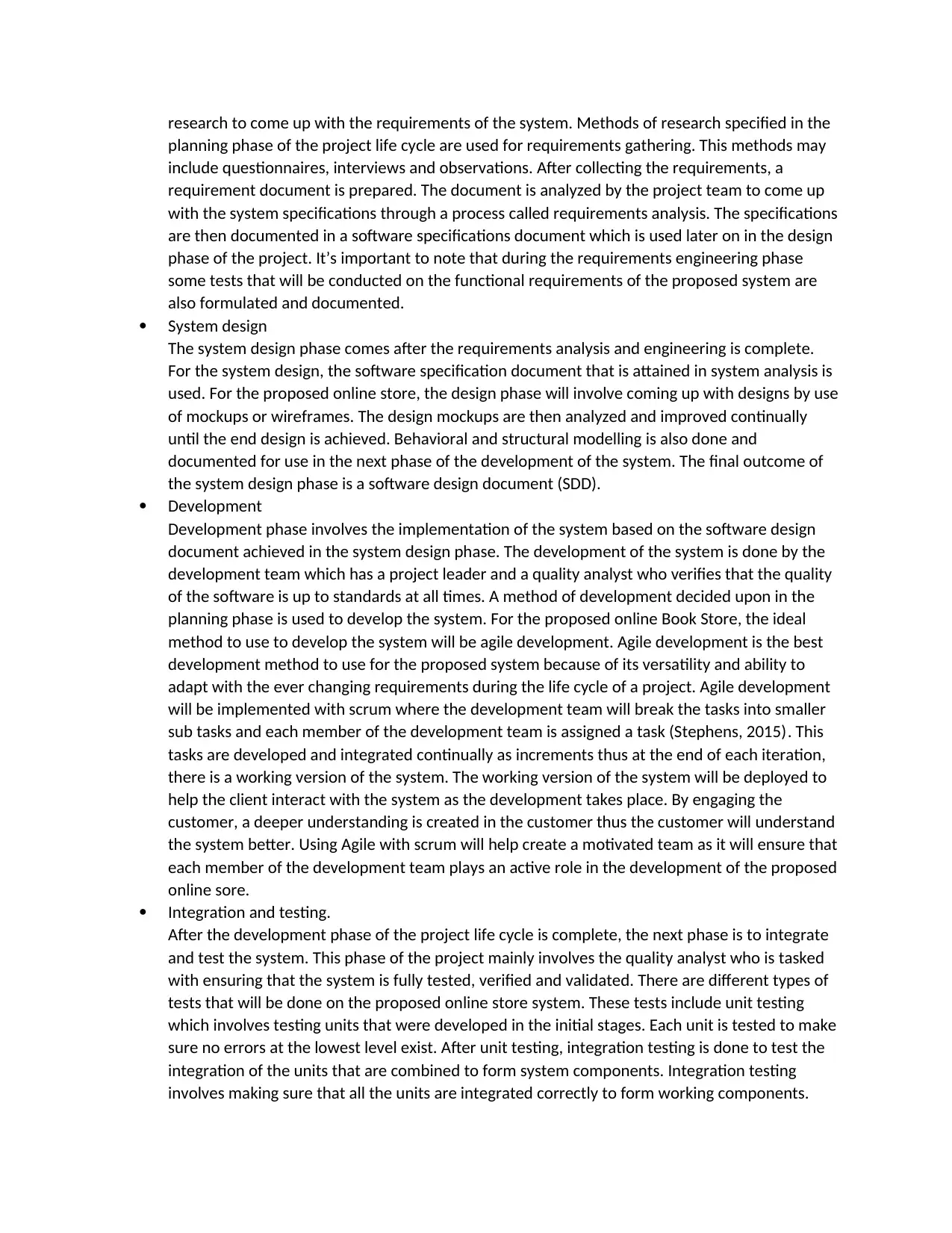
research to come up with the requirements of the system. Methods of research specified in the
planning phase of the project life cycle are used for requirements gathering. This methods may
include questionnaires, interviews and observations. After collecting the requirements, a
requirement document is prepared. The document is analyzed by the project team to come up
with the system specifications through a process called requirements analysis. The specifications
are then documented in a software specifications document which is used later on in the design
phase of the project. It’s important to note that during the requirements engineering phase
some tests that will be conducted on the functional requirements of the proposed system are
also formulated and documented.
System design
The system design phase comes after the requirements analysis and engineering is complete.
For the system design, the software specification document that is attained in system analysis is
used. For the proposed online store, the design phase will involve coming up with designs by use
of mockups or wireframes. The design mockups are then analyzed and improved continually
until the end design is achieved. Behavioral and structural modelling is also done and
documented for use in the next phase of the development of the system. The final outcome of
the system design phase is a software design document (SDD).
Development
Development phase involves the implementation of the system based on the software design
document achieved in the system design phase. The development of the system is done by the
development team which has a project leader and a quality analyst who verifies that the quality
of the software is up to standards at all times. A method of development decided upon in the
planning phase is used to develop the system. For the proposed online Book Store, the ideal
method to use to develop the system will be agile development. Agile development is the best
development method to use for the proposed system because of its versatility and ability to
adapt with the ever changing requirements during the life cycle of a project. Agile development
will be implemented with scrum where the development team will break the tasks into smaller
sub tasks and each member of the development team is assigned a task (Stephens, 2015). This
tasks are developed and integrated continually as increments thus at the end of each iteration,
there is a working version of the system. The working version of the system will be deployed to
help the client interact with the system as the development takes place. By engaging the
customer, a deeper understanding is created in the customer thus the customer will understand
the system better. Using Agile with scrum will help create a motivated team as it will ensure that
each member of the development team plays an active role in the development of the proposed
online sore.
Integration and testing.
After the development phase of the project life cycle is complete, the next phase is to integrate
and test the system. This phase of the project mainly involves the quality analyst who is tasked
with ensuring that the system is fully tested, verified and validated. There are different types of
tests that will be done on the proposed online store system. These tests include unit testing
which involves testing units that were developed in the initial stages. Each unit is tested to make
sure no errors at the lowest level exist. After unit testing, integration testing is done to test the
integration of the units that are combined to form system components. Integration testing
involves making sure that all the units are integrated correctly to form working components.
planning phase of the project life cycle are used for requirements gathering. This methods may
include questionnaires, interviews and observations. After collecting the requirements, a
requirement document is prepared. The document is analyzed by the project team to come up
with the system specifications through a process called requirements analysis. The specifications
are then documented in a software specifications document which is used later on in the design
phase of the project. It’s important to note that during the requirements engineering phase
some tests that will be conducted on the functional requirements of the proposed system are
also formulated and documented.
System design
The system design phase comes after the requirements analysis and engineering is complete.
For the system design, the software specification document that is attained in system analysis is
used. For the proposed online store, the design phase will involve coming up with designs by use
of mockups or wireframes. The design mockups are then analyzed and improved continually
until the end design is achieved. Behavioral and structural modelling is also done and
documented for use in the next phase of the development of the system. The final outcome of
the system design phase is a software design document (SDD).
Development
Development phase involves the implementation of the system based on the software design
document achieved in the system design phase. The development of the system is done by the
development team which has a project leader and a quality analyst who verifies that the quality
of the software is up to standards at all times. A method of development decided upon in the
planning phase is used to develop the system. For the proposed online Book Store, the ideal
method to use to develop the system will be agile development. Agile development is the best
development method to use for the proposed system because of its versatility and ability to
adapt with the ever changing requirements during the life cycle of a project. Agile development
will be implemented with scrum where the development team will break the tasks into smaller
sub tasks and each member of the development team is assigned a task (Stephens, 2015). This
tasks are developed and integrated continually as increments thus at the end of each iteration,
there is a working version of the system. The working version of the system will be deployed to
help the client interact with the system as the development takes place. By engaging the
customer, a deeper understanding is created in the customer thus the customer will understand
the system better. Using Agile with scrum will help create a motivated team as it will ensure that
each member of the development team plays an active role in the development of the proposed
online sore.
Integration and testing.
After the development phase of the project life cycle is complete, the next phase is to integrate
and test the system. This phase of the project mainly involves the quality analyst who is tasked
with ensuring that the system is fully tested, verified and validated. There are different types of
tests that will be done on the proposed online store system. These tests include unit testing
which involves testing units that were developed in the initial stages. Each unit is tested to make
sure no errors at the lowest level exist. After unit testing, integration testing is done to test the
integration of the units that are combined to form system components. Integration testing
involves making sure that all the units are integrated correctly to form working components.
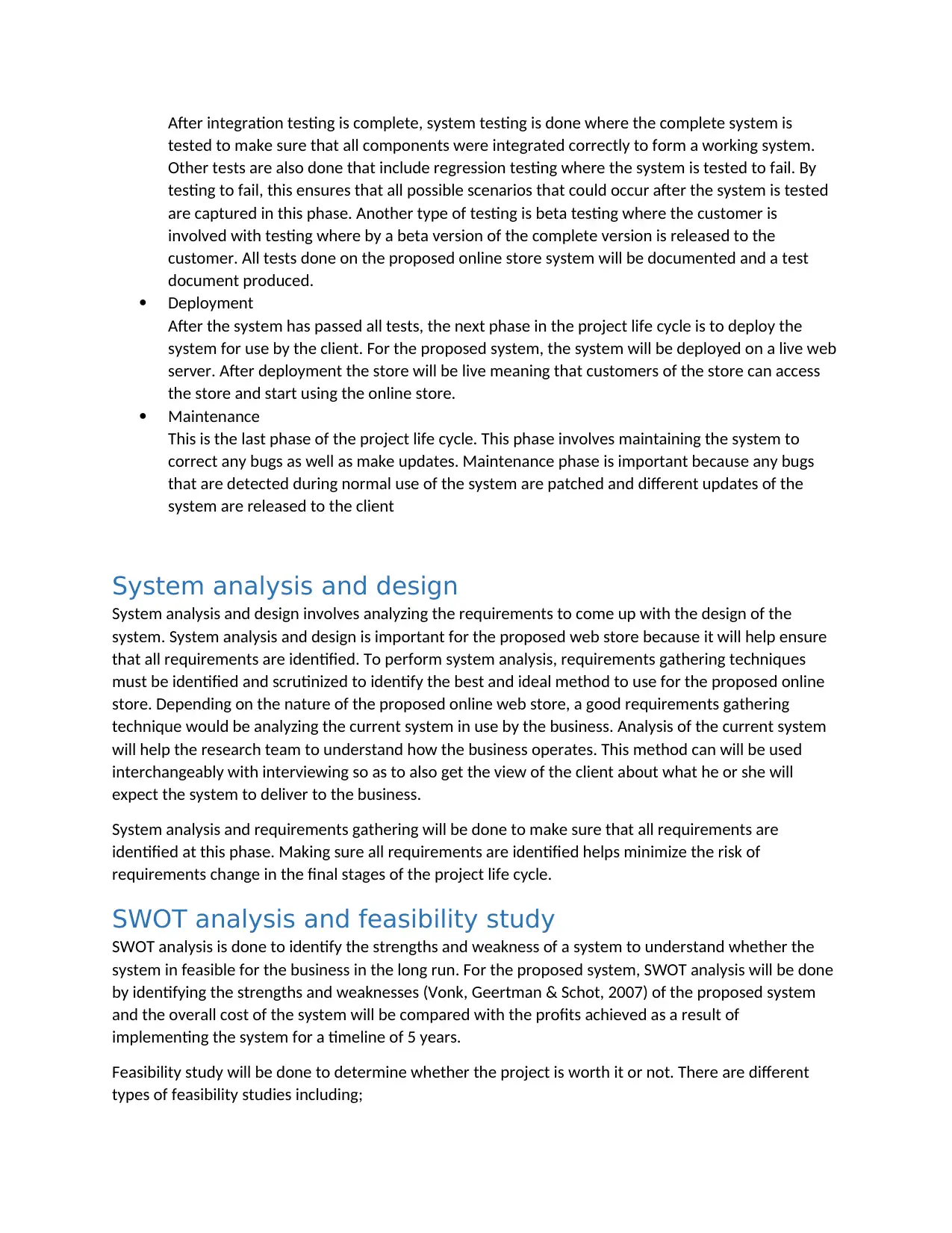
After integration testing is complete, system testing is done where the complete system is
tested to make sure that all components were integrated correctly to form a working system.
Other tests are also done that include regression testing where the system is tested to fail. By
testing to fail, this ensures that all possible scenarios that could occur after the system is tested
are captured in this phase. Another type of testing is beta testing where the customer is
involved with testing where by a beta version of the complete version is released to the
customer. All tests done on the proposed online store system will be documented and a test
document produced.
Deployment
After the system has passed all tests, the next phase in the project life cycle is to deploy the
system for use by the client. For the proposed system, the system will be deployed on a live web
server. After deployment the store will be live meaning that customers of the store can access
the store and start using the online store.
Maintenance
This is the last phase of the project life cycle. This phase involves maintaining the system to
correct any bugs as well as make updates. Maintenance phase is important because any bugs
that are detected during normal use of the system are patched and different updates of the
system are released to the client
System analysis and design
System analysis and design involves analyzing the requirements to come up with the design of the
system. System analysis and design is important for the proposed web store because it will help ensure
that all requirements are identified. To perform system analysis, requirements gathering techniques
must be identified and scrutinized to identify the best and ideal method to use for the proposed online
store. Depending on the nature of the proposed online web store, a good requirements gathering
technique would be analyzing the current system in use by the business. Analysis of the current system
will help the research team to understand how the business operates. This method can will be used
interchangeably with interviewing so as to also get the view of the client about what he or she will
expect the system to deliver to the business.
System analysis and requirements gathering will be done to make sure that all requirements are
identified at this phase. Making sure all requirements are identified helps minimize the risk of
requirements change in the final stages of the project life cycle.
SWOT analysis and feasibility study
SWOT analysis is done to identify the strengths and weakness of a system to understand whether the
system in feasible for the business in the long run. For the proposed system, SWOT analysis will be done
by identifying the strengths and weaknesses (Vonk, Geertman & Schot, 2007) of the proposed system
and the overall cost of the system will be compared with the profits achieved as a result of
implementing the system for a timeline of 5 years.
Feasibility study will be done to determine whether the project is worth it or not. There are different
types of feasibility studies including;
tested to make sure that all components were integrated correctly to form a working system.
Other tests are also done that include regression testing where the system is tested to fail. By
testing to fail, this ensures that all possible scenarios that could occur after the system is tested
are captured in this phase. Another type of testing is beta testing where the customer is
involved with testing where by a beta version of the complete version is released to the
customer. All tests done on the proposed online store system will be documented and a test
document produced.
Deployment
After the system has passed all tests, the next phase in the project life cycle is to deploy the
system for use by the client. For the proposed system, the system will be deployed on a live web
server. After deployment the store will be live meaning that customers of the store can access
the store and start using the online store.
Maintenance
This is the last phase of the project life cycle. This phase involves maintaining the system to
correct any bugs as well as make updates. Maintenance phase is important because any bugs
that are detected during normal use of the system are patched and different updates of the
system are released to the client
System analysis and design
System analysis and design involves analyzing the requirements to come up with the design of the
system. System analysis and design is important for the proposed web store because it will help ensure
that all requirements are identified. To perform system analysis, requirements gathering techniques
must be identified and scrutinized to identify the best and ideal method to use for the proposed online
store. Depending on the nature of the proposed online web store, a good requirements gathering
technique would be analyzing the current system in use by the business. Analysis of the current system
will help the research team to understand how the business operates. This method can will be used
interchangeably with interviewing so as to also get the view of the client about what he or she will
expect the system to deliver to the business.
System analysis and requirements gathering will be done to make sure that all requirements are
identified at this phase. Making sure all requirements are identified helps minimize the risk of
requirements change in the final stages of the project life cycle.
SWOT analysis and feasibility study
SWOT analysis is done to identify the strengths and weakness of a system to understand whether the
system in feasible for the business in the long run. For the proposed system, SWOT analysis will be done
by identifying the strengths and weaknesses (Vonk, Geertman & Schot, 2007) of the proposed system
and the overall cost of the system will be compared with the profits achieved as a result of
implementing the system for a timeline of 5 years.
Feasibility study will be done to determine whether the project is worth it or not. There are different
types of feasibility studies including;
⊘ This is a preview!⊘
Do you want full access?
Subscribe today to unlock all pages.

Trusted by 1+ million students worldwide
1 out of 14
Your All-in-One AI-Powered Toolkit for Academic Success.
+13062052269
info@desklib.com
Available 24*7 on WhatsApp / Email
![[object Object]](/_next/static/media/star-bottom.7253800d.svg)
Unlock your academic potential
Copyright © 2020–2025 A2Z Services. All Rights Reserved. Developed and managed by ZUCOL.
